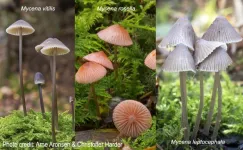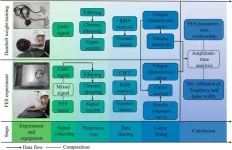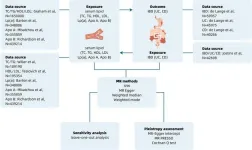(Press-News.org) A study of multiple Mycena mushroom species reported in the journal Cell Genomics has found that they have unexpectedly large genomes. While the mushrooms had been thought to be purely saprotrophic – living by degrading dead organic material alone – the discovery suggests that they may instead have a collection of genes to enable them to adapt to different lifestyles as circumstances change. Interestingly, they show certain Mycena strains living in the Arctic have some of the largest mushroom genomes ever described.
These mushrooms show widespread growth across their genome. This includes not only the genes that help them invade or interact with plants and break down carbon, but also genes whose functions are not yet known but are likely important. Additionally, there are many repetitive, non-coding elements and genes that they have acquired from other, unrelated fungi through horizontal gene transfer.
“The Mycena samples were collected in Northern Europe, and one of our collaborators gathered samples from the Arctic area. Three of these were successfully sequenced, and we found that these Arctic species contained significantly larger genomes compared to ordinary Mycena species,” explained Dr. Shingo Miyauchi, co-lead author at the Okinawa Institute of Science and Technology (OIST)’s Evolutionary and Synthetic Biology Unit. “My initial impression was that this is not normal, so we contacted our collaborators who verified the genome assembly’s correctness. We then concluded that these highly expanded genomes were unique to certain Arctic Mycena species.”
“Evolution tells us that non-advantageous traits tend to disappear over time, so an obvious implication is that adaptability and generalism in those large genome structures must be an advantage for these fungi,” added Francis Martin of the INRAE (French National Research Institute for Agriculture, Food and Environment) and the University of Lorraine in Champenoux, France. “This is despite the costs of having a large genome with lots of possibly unnecessary features that must be replicated in each cell division. This may be particularly true in an extreme environment like the Arctic, as also seen in plants.”
The researchers set out to study Mycena based on their role as a main mushroom decomposer of litter and leaves in forest ecosystems. Despite their tiny fruiting bodies, Mycena have an important role in the global carbon cycle. This group of mushrooms had long been thought to live purely on dead organic material, but more recently it was found that some species also make a living through cooperative or parasitic interactions with living plants. Mycenas are also bioluminescent – i.e. they glow in the dark – and earlier work describing the genomes of five Mycena species had investigated this phenomenon. To learn more about their direct lifestyle habits, the researchers now wanted to study a broad palette of Mycena species with different preferences for substrates.
In the new study, they generated new genome sequences for 24 additional Mycena species and a related species now known as Atheniella floridula. The species included represent six decayer categories: wood generalists, broadleaf wood decayers, grass litter generalists, broadleaf litter decayers, coniferous litter decayers, and overall litter generalists. It also included three Arctic species. They added their new genomes to 33 additional genomes from non-Mycena species. They wanted to understand how the genomes had evolved and expanded over evolutionary time and how species might differ in plant cell wall-degrading enzymes based on their lifestyle habits.
They were surprised to find that Mycena showed massive genome expansions overall, affecting all gene families regardless of their expected habits. The expansion appeared to be driven by the emergence of novel genes as well as gene duplications, enlarged collections of genes that produce enzymes for degrading polysaccharides, the proliferation of transposable elements, and horizontal gene transfers from other fungal species. They also found that two species collected in the Arctic had the largest genomes by far, at a size that is two to eight times bigger than Mycena living in temperate zones.
The researchers were particularly surprised to find that the genomes of the Arctic species expanded significantly beyond the general Mycena expansion. Additionally, they discovered that Mycena fungi had acquired genes from Ascomycetes through horizontal gene transfer. These species are also found in temperate regions, but it remains unclear whether their large size is due to specific species characteristics or an effect related to the Arctic environment.
However, some Arctic plants have been shown to inflate their genomes with transposable elements, or simply duplicate their entire genomes altogether compared to their close relatives in temperate areas, and it is of course tempting to suggest that a similar parallel evolution could be happening in Arctic mushrooms.
“The evolutionary transition from decomposer to symbiotic fungi is generally believed to have happened in parallel in several fungal groups throughout the course of evolution millions of years ago,” says Håvard Kauserud of the University of Oslo, Norway. “However, with Mycena, we appear to be seeing this gradual process in action happening right in front of our eyes.”
“We know from other lines of research that Mycena, contrary to many other fungi, can adopt more than one possible lifestyle. The findings suggest that these multiple possible lifestyles are reflected in their genome structures, too”, said Christoffer Bugge Harder, co-lead author at the University of Oslo.
The findings also have important implications for efforts to understand an organism’s habits from their genome sequences alone.
As a data scientist with a strong interest in visual art, Dr. Miyauchi enjoys being creative with data visualization: “I spent two years comparing fungal genome features for this study and was inspired by the colors of these tiny mushrooms. The figures I created were influenced by the 19th century French impressionist, Pierre-Auguste Renoir.” He is currently working on a project sequencing genomes of rare deep-sea fungi which differ significantly from forest fungi. “Our goal is genome mining to uncover unusual genes, enzymes, and metabolites. Ultimately, we aim to isolate unique genomic materials for biotechnological applications. It’s my hope that funding bodies recognize the huge future potential of petite mushrooms,” he said.
This article is based on a press release published by Cell Press and edited by OIST science writer Merle Naidoo.
END
These mushrooms have “massively expanded” genomes to make them more adaptable to multiple lifestyles
Certain Mycena strains living in the Arctic have some of the largest mushroom genomes ever described.
2024-06-27
ELSE PRESS RELEASES FROM THIS DATE:
AAAS and BII inaugurate new prize recognizing translational achievements in women’s health
2024-06-27
In collaboration with the BioInnovation Institute (BII), AAAS is announcing the establishment of the BII & Science Translational Medicine Prize for Innovations in Women’s Health. Submissions are now open for the first year of the prize, which will be awarded in 2025.
The new award will aim to recognize and elevate scientists who have made outstanding research discoveries that have translational potential to impact women’s health around the world.
Relevant research topics include, but are not limited to, investigation into maternal health and gynecological conditions, areas of ...
$10.5M biomaterials center to connect researchers, fund innovation and fight resource discrimination
2024-06-27
Images
Simultaneously advancing biomaterials research with clinical applications and connecting researchers at well-resourced institutions with those rich in diverse talent is the aim of a $10.5 million center supported by the National Institutes of Health.
The Humanity Unlocking Biomaterials center, led by the University of Michigan and University of Washington, is designed to spur the development of biomaterials solutions that have potential in medical treatments by bringing together researchers and providing seed funding to kickstart ...
Last segment of the world’s largest telescope mirror successfully cast
2024-06-27
The European Southern Observatory’s Extremely Large Telescope (ESO’s ELT), under construction in the Chilean Atacama Desert, is one step closer to completion. German company SCHOTT has successfully cast the blank for the last of the 949 segments commissioned for the telescope’s primary mirror (M1). With a diameter of more than 39 metres, M1 will be by far the largest mirror ever made for a telescope.
Too large to be made from a single piece of glass, M1 will consist of 798 hexagonal segments, each about five centimetres thick and 1.5 ...
Climate change and sea level rise pose an acute challenge for cities with combined sewer systems
2024-06-27
Older coastal cities, like Philadelphia, New York and Boston are at risk of being inundated by untreated sewage during floods. Due in part to the design of their combined sewer systems and in part due to sea level rise, these cities could be facing a growing public health crisis as climate change also drives more extreme precipitation, according to researchers at Drexel University who study urban stormwater management. The group recently published research that modeled the potential extent of the problem in a section of the coastal city of Camden, New Jersey, and the effectiveness of one proposed intervention to help ...
Revolutionary study finds optimal FES settings for enhancing muscle recovery training
2024-06-27
At present, stroke has become one of the most serious neurological diseases, which is usually accompanied by movement disorders and cognitive impairment. In recent years, the number of stroke patients has increased annually . Most stroke patients are accompanied by movement disorders, which seriously affect the normal life of patients. A groundbreaking study conducted by Shihao Sun and colleagues, recently published in the Cyborg Bionic Systems journal, has introduced innovative findings in the realm of Functional Electrical Stimulation (FES), particularly its application in muscle recovery and fatigue management.
Functional ...
MD Anderson and Rice launch Cancer Bioengineering Collaborative
2024-06-27
HOUSTON ― The University of Texas MD Anderson Cancer Center and Rice University today announced the creation of the Cancer Bioengineering Collaborative to develop innovative technologies and bioengineering approaches to improve cancer research, diagnosis and treatment.
Led by Rice’s Gang Bao, Ph.D., and MD Anderson’s Jeffrey Molldrem, M.D., the initiative aims to foster collaboration between the two institutions on fundamental and translational cancer research, to develop new technologies for cancer detection and therapy, and to secure external funding in support of further research and training.
Envisioned as a hub for accelerating ...
Harnessing musculoskeletal modeling: A leap forward in personalized muscle strength assessment
2024-06-27
Researchers have developed an innovative method for assessing spinal muscle strength, utilizing isokinetic testing combined with advanced spine musculoskeletal modeling. This cutting-edge approach, detailed in a study published by the Cyborg and Bionic Systems journal, marks a significant advancement in personalized health and athletic training.
Understanding individual muscle strength is crucial for optimizing physical therapy and enhancing athletic performance. Traditional methods, however, often fall short in precision. The newly introduced technique by Zuming Xiao and colleagues from the Beijing Institute of Technology and Shenyang ...
MIT Press journals earn high impact factors in 2023, with notable strength in linguistics
2024-06-27
We are pleased to share that many MIT Press journals were ranked highly in their fields in 2023, earning exceptional impact factors—which measure recent citation activity for scholarship—and placing in the top quartile of all journals for their areas of study.
Several MIT Press journals in linguistics landed in the top of the field—including Transactions of the Association for Computational Linguistics at #6 out of all 297 linguistics journals in publication; Computational Linguistics at #10; Neurobiology of Language at #14; and Linguistic Inquiry at #77. We ...
New research shows that solar-powered “resilience hubs” in California could generate up to 8GW of power -- providing emergency assistance to vulnerable residents during power outages
2024-06-27
OAKLAND, Calif., June 27, 2024 – Power outages are on the rise nationwide as climate change brings more frequent wildfires, heat waves, and severe weather events. The Federal Emergency Management Agency (FEMA) and the state of California have both recently established funding to help communities create “resilience hubs” that rely on solar+battery systems to provide emergency power for residents.
A new study in the journal Risk Analysis finds that strategically placing resilience hubs throughout California could generate up to 8 GW of solar energy and lower the state’s carbon emissions by 5 million tons ...
Null causal relationship between inflammatory bowel disease and lipid profile
2024-06-27
A new study has illuminated the connection between inflammatory bowel disease (IBD) and lipid profile. IBD is a chronic condition that causes inflammation in the intestines. Abnormal lipid factor levels such as cholesterol in IBD patients have been observed in previous studies, but whether this association is causal remained unclear.
This study employed Mendelian randomization (MR) to investigate the potential causal link between lipid profile and IBD. The results revealed no significant ...
LAST 30 PRESS RELEASES:
Review article | Towards a Global Ground-Based Earth Observatory (GGBEO): Leveraging existing systems and networks
Penn and UMich create world’s smallest programmable, autonomous robots
Cleveland researchers launch first major study to address ‘hidden performance killer’ in athletes
To connect across politics, try saying what you oppose
Modulating key interaction prevents virus from entering cells
Project explores barriers to NHS career progression facing international medical graduates
Jeonbuk National University researchers explore the impact of different seasonings on the flavor perception of Doenjang soup
Two Keck Medicine of USC Hospitals named Leapfrog Top Teaching Hospitals
World-first discovery uncovers how glioblastoma tumours dodge chemotherapy, potentially opening the door to new treatments
A fatal mix-up: How certain gut bacteria drive multiple sclerosis
New AI tool identifies not just genetic mutations, but the diseases they may cause
Deep-learning model predicts how fruit flies form, cell by cell
Combination pills for high blood pressure may simplify treatment, improve long-term health
Immune system keeps mucosal fungi in check
Neurons within the brain use simple rules to localize genetic messages
Electrodes created using light
Second-hand gift-giving is a well-deliberated decision
How human interaction drove evolution to make bears less aggressive
National Poll: Few parents offer teens guidance on healthy eating during holiday season
Cannabis derivatives could provide new ovarian cancer treatments
Raising strong yeast as a petroleum substitute
Clues to the origin of hot Jupiters hidden in their orbits
Canada’s reduced pledge to Global Fund will impact domestic health
1 in 4 children with major traumatic injuries not cared for in pediatric trauma centres
Duke and Duke-NUS’ joint cross-population research to uncover "East-West" differences in disease and care
Scientists to ‘spy’ on cancer- immune cell interactions using quantum technology breakthrough
Tech savvy users have most digital concerns
Making lighter work of calculating fluid and heat flow
Normalizing blood sugar can halve heart attack risk
Lowering blood sugar cuts heart attack risk in people with prediabetes
[Press-News.org] These mushrooms have “massively expanded” genomes to make them more adaptable to multiple lifestylesCertain Mycena strains living in the Arctic have some of the largest mushroom genomes ever described.






